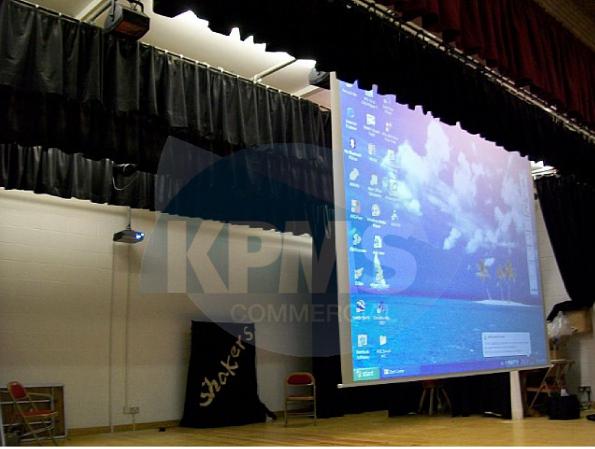The main advantage of a rear projection screen is standing in front of it without blocking light from the projector. This is beneficial for presentations and increases the number of potential locations for the projector.
Another advantage of rear projection screens is improved contrast and image quality because it separates the light path from the audience. Audiences see a crisp image with no light bleed, which improves their viewing experience.
What is the difference between front and rear projection screens?
Rear projection screens diffuse light through the screen material, while front projection screens reflect light. The projector’s location is the key difference; rear screens have a rear-mounted projector to display the image.
Rear projection screens are available in the same sizes as front projection screens, which are compatible with all standard projectors. However, you will need a powerful projector to push enough light through the screen.
What are the advantages of rear projection screens?
These are the main advantages of rear projection screens:
- Higher contrast
- Better for brightly lit places
- Better for outdoor use
- No light path distractions
- Stand in front of it without blocking the projection
There are also a few disadvantages:
- Powerful projector required to preserve image quality
- Some light is not diffused, which can wash out images
- More space is needed in general versus front projection
How much space do you need for a rear projection screen?
As with all projection screens, the space required for rear projection depends on the ‘throw’ of the projector. The ‘throw’ of a projector determines the image size at a distance, and it tells us how big an image will be from a certain distance away.
You will come across three types of throw:
- Regular throw (1.5:1 +)
- Short throw (0.38:1 – 1.4:1)
- Ultra-short throw (0.37:1 or less)
Based on your installation location, you should select a projector by measuring the ideal distance between the projector and your rear projector screen.
Do you need a special projector for rear projection?
While all projectors can reverse/flip an image for rear projection, the projector needs to output a sufficiently bright image to push light through the screen for diffusion. Otherwise, the image quality will suffer.
We recommend no less than 3,000 lumens for rear projection indoors and 4,000 lumens if you intend to use the projector outdoors and in bright spaces.
Who should choose rear projection?
Rear projection is best in spaces where front projection is impractical. This could be because the proposed projector location will create distracting light output or because presenters will obscure the light path walking in front of the screen.
Rear projection is also best for outdoor spaces; light is diffused through the screen instead of reflected forward, making it easier to see in bright spaces. Most outdoor projection setups make use of rear projection.
Find out more about rear projection screens
If you have any questions about rear projector screens, call our installation team on 01924 423 111 or email info@KPMS.co.uk for a chat.



